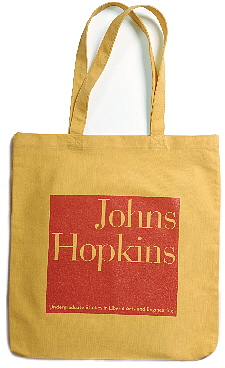Vignette
 Johns Hopkins' Homewood campus is a showplace for all sorts
of fashion statements — five-inch heels and $200
jeans, flip-flops worn as snow boots and oversized starlet
sunglasses.
Johns Hopkins' Homewood campus is a showplace for all sorts
of fashion statements — five-inch heels and $200
jeans, flip-flops worn as snow boots and oversized starlet
sunglasses.
Now there's a new hot accessory at Homewood: a bright
yellow canvas bag with the university's name in a red
square. Visitors use it to tote admissions materials, maps,
and guides.
It carries a mission with it, too. When faculty, staff, and
students spot a visitor carrying one of these distinctive
totes, they are to take it as an invitation to offer
directions, a greeting, or simply a smile.
The "Spot a Bag . . . make a friend" campaign was designed
to make the Homewood campus more collegial and to attract
more applicants in the process. A recent admissions
marketing positioning study found that many prospective
students ultimately chose not to attend Hopkins because
they thought it wasn't friendly.
"When they only spend an hour and a half on your campus,
people have these very superficial reactions," explains
William Conley, dean of
enrollment and
academic services. "We found that their experiences
seemed to be more about brick and mortar than community.
This is a beautiful campus, but at the end of the day you
want to like the feel of this place."
The bags are just part of a marketing campaign aimed at
helping the Hopkins community connect with visitors, Conley
says. Other efforts include a revamped admissions Web site
that features pictures of Hopkins people, and campus tours
in which student guides focus on the many positive changes
to the Homewood campus.
More friendliness is on the way. Welcome banners have been
hung inside Garland Hall and outside Levering, and "Ask me
anything!" lapel buttons will be the new must-have
accessory for admissions staff. — MB















 The Johns Hopkins Magazine |
901 S. Bond St. | Suite 540 |
Baltimore, MD 21231
The Johns Hopkins Magazine |
901 S. Bond St. | Suite 540 |
Baltimore, MD 21231